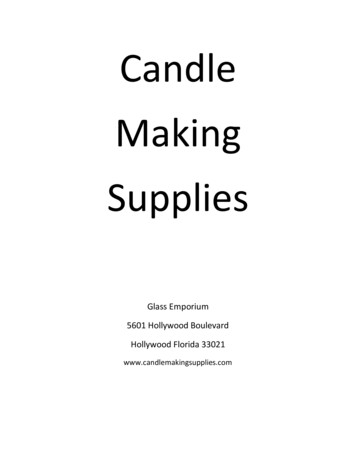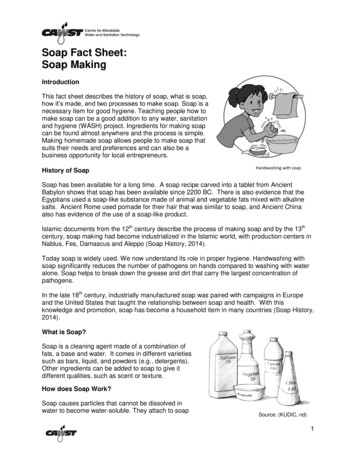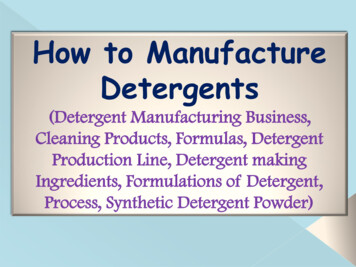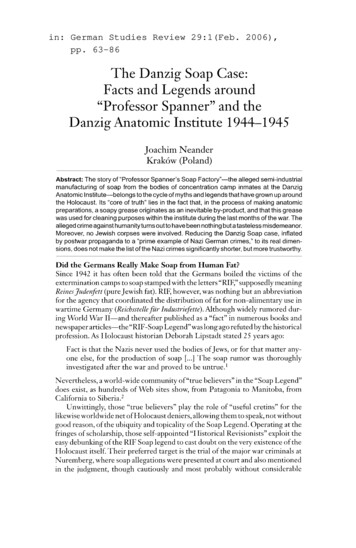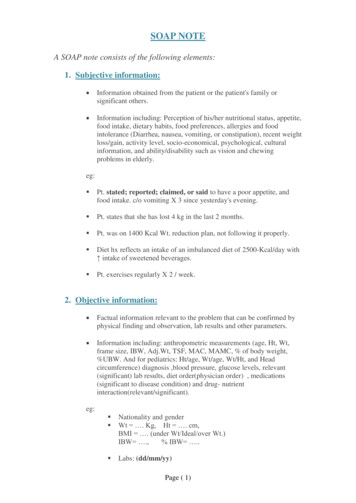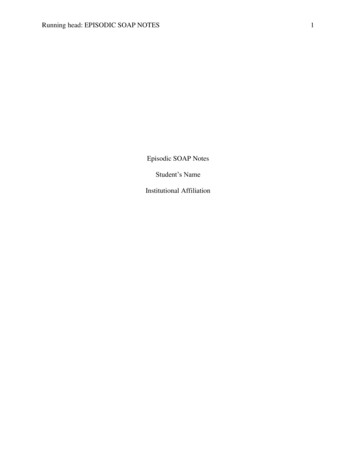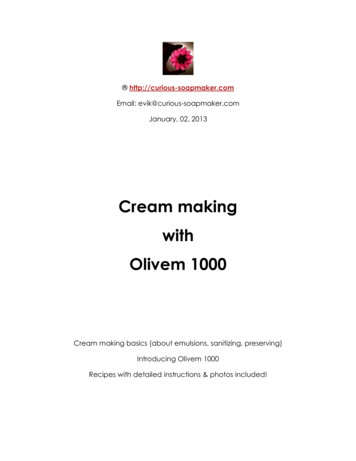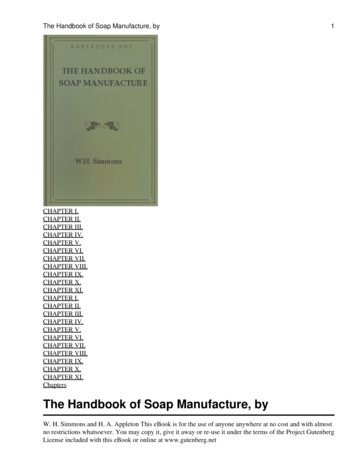
Transcription
The Handbook of Soap Manufacture, by1CHAPTER I.CHAPTER II.CHAPTER III.CHAPTER IV.CHAPTER V.CHAPTER VI.CHAPTER VII.CHAPTER VIII.CHAPTER IX.CHAPTER X.CHAPTER XI.CHAPTER I.CHAPTER II.CHAPTER III.CHAPTER IV.CHAPTER V.CHAPTER VI.CHAPTER VII.CHAPTER VIII.CHAPTER IX.CHAPTER X.CHAPTER XI.ChaptersThe Handbook of Soap Manufacture, byW. H. Simmons and H. A. Appleton This eBook is for the use of anyone anywhere at no cost and with almostno restrictions whatsoever. You may copy it, give it away or re-use it under the terms of the Project GutenbergLicense included with this eBook or online at www.gutenberg.net
The Handbook of Soap Manufacture, by2Title: The Handbook of Soap ManufactureAuthor: W. H. Simmons H. A. AppletonRelease Date: June 7, 2007 [EBook #21724]Language: EnglishCharacter set encoding: ISO-8859-1*** START OF THIS PROJECT GUTENBERG EBOOK THE HANDBOOK OF SOAP MANUFACTURE***Produced by Ben Beasley, Richard Prairie, Josephine Paolucci and the Online Distributed Proofreading Teamat http://www.pgdp.net. (This file was produced from images generously made available by The InternetArchive/Million Book Project.)THE HANDBOOK OFSOAP MANUFACTUREBYW. H. SIMMONS, B.Sc. (LOND.), F.C.S.ANDH. A. APPLETONWITH TWENTY-SEVEN ILLUSTRATIONSLONDON SCOTT, GREENWOOD & SON "THE OIL AND COLOUR TRADES JOURNAL" OFFICES 8BROADWAY, LUDGATE HILL, E.C. 1908 [All rights reserved]Transcriber's note:For text: A word surrounded by a cedilla such as this signifies that the word is bolded in the text. A wordsurrounded by underscores like this signifies the word is italics in the text. Greek letters are translated intoEnglish and are in brackets, e.g. [alpha].For numbers and equations: Parentheses have been added to clarify fractions. Underscores before bracketednumbers/letters in equations denote a subscript.Footnotes have been moved to the end of the chapter and minor typos have been corrected.PREFACEIn the general advance of technical knowledge and research during the last decade, the Soap Industry has notremained stationary. While there has not perhaps been anything of a very revolutionary character, steadyprogress has still been made in practically all branches, and the aim of the present work is to describe themanufacture of Household and Toilet Soaps as carried out to-day in an up-to-date and well-equipped factory.
The Handbook of Soap Manufacture, by3In the more scientific portions of the book, an acquaintance with the principles of elementary chemistry isassumed, and in this we feel justified, as in these days of strenuous competition, no soap-maker can hope tocompete successfully with his rivals unless he has a sound theoretical as well as practical knowledge of thenature of the raw materials he uses, and the reactions taking place in the pan, or at other stages of themanufacture. We also venture to hope that the work may prove useful to Works' Chemists and other Analystsconsulted in connection with this Industry.At the same time, in the greater part of the book no chemical knowledge is necessary, the subject being treatedin such a way that it is hoped those who are not directly engaged in the manufacture of soap, but who desire ageneral idea of the subject, will find it of value.In the sections dealing with the composition and analysis of materials, temperatures are expressed in degreesCentigrade, these being now almost invariably used in scientific work. In the rest of the book, however, theyare given in degrees Fahrenheit (the degrees Centigrade being also added in brackets), as in the majority offactories these are still used.As regards strengths of solution, in some factories the use of Baumé degrees is preferred, whilst in othersTwaddell degrees are the custom, and we have therefore given the two figures in all cases.In the chapter dealing with Oils and Fats, their Saponification Equivalents are given in preference toSaponification Values, as it has been our practice for some years to express our results in this way, assuggested by Allen in Commercial Organic Analysis, and all our records, from which most of the figures forthe chief oils and fats are taken, are so stated.For the illustrations, the authors are indebted to Messrs. E. Forshaw & Son, Ltd., H. D. Morgan, and W. J.Fraser & Co., Ltd.W. H. S. H. A. A.LONDON, September, 1908.CONTENTSPAGE
CHAPTER I.CHAPTER I.INTRODUCTION. 1Definition of Soap--Properties--Hydrolysis--Detergent Action.4
CHAPTER II.5CHAPTER II.CONSTITUTION OF OILS AND FATS, AND THEIR SAPONIFICATION 6Researches of Chevreul and Berthelot--Mixed Glycerides--Modern Theories of Saponification--Hydrolysisaccelerated by (1) HEAT OR ELECTRICITY, (2) FERMENTS, Castor-seed Ferment, Steapsin, Emulsin, and(3) CHEMICAL REAGENTS, Sulphuric Acid, Twitchell's Reagent, Hydrochloric Acid, Lime, Magnesia,Zinc Oxide, Soda and Potash.
CHAPTER III.CHAPTER III.RAW MATERIALS USED IN SOAP-MAKING 24Fats and Oils--Waste Fats--Fatty Acids--Less-known Oils and Fats of Limited Use--Various New Fats andOils Suggested for Soap-making--Rosin--Alkali (Caustic and Carbonated)--Water--Salt--Soap-stock.6
CHAPTER IV.CHAPTER IV.BLEACHING AND TREATMENT OF RAW MATERIALS INTENDED FOR SOAP-MAKING 41Palm Oil--Cotton-seed Oil--Cotton-seed "Foots"--Vegetable Oils--Animal Fats--Bone Fat--Rosin.7
CHAPTER V.8CHAPTER V.SOAP-MAKING 45Classification of Soaps--Direct combination of Fatty Acids with Alkali--Cold Process Soaps--Saponificationunder Increased or Diminished Pressure--Soft Soap--Marine Soap--Hydrated Soaps, Smooth andMarbled--Pasting or Saponification--Graining Out--Boiling on Strength--Fitting--Curd Soaps--CurdMottled--Blue and Grey Mottled Soaps--Milling Base--Yellow Household Soaps--Resting of Pans andSettling of Soap--Utilisation of Nigres--Transparent soaps--Saponifying Mineral Oil--Electrical Production ofSoap.
CHAPTER VI.CHAPTER VI.TREATMENT OF SETTLED SOAP 60Cleansing--Crutching--Liquoring of Soaps--Filling--Neutralising, Colouring and arring--Open and Close Piling--Drying--Stamping--Cooling.9
CHAPTER VII.CHAPTER VII.TOILET, TEXTILE AND MISCELLANEOUS SOAPS 77Toilet Soaps--Cold Process soaps--Settled Boiled Soaps--Remelted Soaps--Milled Soaps--Drying--Millingand Incorporating Colour, Perfume, or Medicament--Perfume--Colouring matter--Neutralising andSuperfatting d Soaps--Ether Soap--FloatingSoaps--Shaving Soaps--Textile Soaps--Soaps for Woollen, Cotton and Silk Industries--Patent TextileSoaps--Miscellaneous Soaps.10
CHAPTER VIII.CHAPTER VIII.SOAP PERFUMES 95Essential Oils--Source and Preparation--Properties--Artificial and Synthetic Perfumes.11
CHAPTER IX.CHAPTER IX.GLYCERINE MANUFACTURE AND PURIFICATION 111Treatment of Lyes--Evaporation to Crude Glycerine--Distillation--Distilled and DynamiteGlycerine--Chemically Pure Glycerine--Animal Charcoal for Decolorisation--Glycerine obtained by othermethods of Saponification--Yield of Glycerine from Fats and Oils.12
CHAPTER X.CHAPTER X.ANALYSIS OF RAW MATERIALS, SOAP, AND GLYCERINE 117Fats and Oils--Alkalies and Alkali Salts--Essential Oils--Soap--Lyes--Crude Glycerine.13
CHAPTER XI.CHAPTER XI.STATISTICS OF THE SOAP INDUSTRY 140APPENDIX A.COMPARISON OF DEGREES, TWADDELL AND BAUMÉ, WITH ACTUAL DENSITIES 147APPENDIX B.COMPARISON OF DIFFERENT THERMOMETRIC SCALES 148APPENDIX C.TABLE OF THE SPECIFIC GRAVITIES OF SOLUTIONS OF CAUSTIC SODA 149APPENDIX D.TABLE OF STRENGTH OF CAUSTIC POTASH SOLUTIONS AT 60 F. 151INDEX 15314
CHAPTER I.15CHAPTER I.INTRODUCTION.Definition of Soap--Properties--Hydrolysis--Detergent Action.It has been said that the use of soap is a gauge of the civilisation of a nation, but though this may perhaps be ina great measure correct at the present day, the use of soap has not always been co-existent with civilisation,for according to Pliny (Nat. Hist., xxviii., 12, 51) soap was first introduced into Rome from Germany, havingbeen discovered by the Gauls, who used the product obtained by mixing goats' tallow and beech ash for givinga bright hue to the hair. In West Central Africa, moreover, the natives, especially the Fanti race, have beenaccustomed to wash themselves with soap prepared by mixing crude palm oil and water with the ashes ofbanana and plantain skins. The manufacture of soap seems to have flourished during the eighth century inItaly and Spain, and was introduced into France some five hundred years later, when factories wereestablished at Marseilles for the manufacture of olive-oil soap. Soap does not appear to have been made inEngland until the fourteenth century, and the first record of soap manufacture in London is in 1524. From thistime till the beginning of the nineteenth century the manufacture of soap developed very slowly, beingessentially carried on by rule-of-thumb methods, but the classic researches of Chevreul on the constitution offats at once placed the industry upon a scientific basis, and stimulated by Leblanc's discovery of a process forthe commercial manufacture of caustic soda from common salt, the production of soap has advanced by leapsand bounds until it is now one of the most important of British industries.Definition of Soap.--The word soap (Latin sapo, which is cognate with Latin sebum, tallow) appears to havebeen originally applied to the product obtained by treating tallow with ashes. In its strictly chemical sense itrefers to combinations of fatty acids with metallic bases, a definition which includes not only sodium stearate,oleate and palmitate, which form the bulk of the soaps of commerce, but also the linoleates of lead,manganese, etc., used as driers, and various pharmaceutical preparations, e.g., mercury oleate (Hydrargyrioleatum), zinc oleate and lead plaster, together with a number of other metallic salts of fatty acids. Technicallyspeaking, however, the meaning of the term soap is considerably restricted, being generally limited to thecombinations of fatty acids and alkalies, obtained by treating various animal or vegetable fatty matters, or thefatty acids derived therefrom, with soda or potash, the former giving hard soaps, the latter soft soaps.The use of ammonia as an alkali for soap-making purposes has often been attempted, but owing to the easewith which the resultant soap is decomposed, it can scarcely be looked upon as a product of much commercialvalue.H. Jackson has, however, recently patented (Eng. Pat. 6,712, 1906) the use of ammonium oleate for laundrywork. This detergent is prepared in the wash-tub at the time of use, and it is claimed that goods are cleansedby merely immersing them in this solution for a short time and rinsing in fresh water.Neither of the definitions given above includes the sodium and potassium salts of rosin, commonly calledrosin soap, for the acid constituents of rosin have been shown to be aromatic, but in view of the analogousproperties of these resinates to true soap, they are generally regarded as legitimate constituents of soap, havingbeen used in Great Britain since 1827, and receiving legislative sanction in Holland in 1875.Other definitions of soap have been given, based not upon its composition, but upon its properties, amongwhich may be mentioned that of Kingzett, who says that "Soap, considered commercially, is a body which ontreatment with water liberates alkali," and that of Nuttall, who defines soap as "an alkaline or unctuoussubstance used in washing and cleansing".Properties of Soap.--Both soda and potash soaps are readily soluble in either alcohol or hot water. In coldwater they dissolve more slowly, and owing to slight decomposition, due to hydrolysis (vide infra), the
CHAPTER I.16solution becomes distinctly turbid. Sodium oleate is peculiar in not undergoing hydrolysis except in verydilute solution and at a low temperature. On cooling a hot soap solution, a jelly of more or less firmconsistence results, a property possessed by colloidal bodies, such as starch and gelatine, in contradistinctionto substances which under the same conditions deposit crystals, due to diminished solubility of the salt at alower temperature.Krafft (Journ. Soc. Chem. Ind., 1896, 206, 601; 1899, 691; and 1902, 1301) and his collaborators, Wiglow,Strutz and Funcke, have investigated this property of soap solutions very fully, the researches extending overseveral years. In the light of their more recent work, the molecules, or definite aggregates of molecules, ofsolutions which become gelatinous on cooling move much more slowly than the molecules in the formation ofa crystal, but there is a definite structure, although arranged differently to that of a crystal. In the case of sodasoaps the colloidal character increases with the molecular weight of the fatty acids.Soda soaps are insoluble in concentrated caustic lyes, and, for the most part, in strong solutions of sodiumchloride, hence the addition of caustic soda or brine to a solution of soda soap causes the soap to separate outand rise to the surface. Addition of brine to a solution of potash soap, on the other hand, merely results indouble decomposition, soda soap and potassium chloride being formed, thus:-C{17}H{35}COOK NaCl C{17}H{35}COONa KCl potassium sodium sodium potassium stearatechloride stearate chlorideThe solubility of the different soaps in salt solution varies very considerably. Whilst sodium stearate isinsoluble in a 5 per cent. solution of sodium chloride, sodium laurate requires a 17 per cent. solution toprecipitate it, and sodium caproate is not thrown out of solution even by a saturated solution.Hydrolysis of Soap.--The term "hydrolysis" is applied to any resolution of a body into its constituents wherethe decomposition is brought about by the action of water, hence when soap is treated with cold water, it issaid to undergo hydrolysis, the reaction taking place being represented in its simplest form by the equation:-2NaC{18}H{35}O{2} H{2}O NaOH HNa(C{18}H{35}O{2}){2} sodium water caustic acid sodiumstearate soda stearateThe actual reaction which occurs has been the subject of investigation by many chemists, and very diverseconclusions have been arrived at. Chevreul, the pioneer in the modern chemistry of oils and fats, found that asmall amount of alkali was liberated, as appears in the above equation, together with the formation of an acidsalt, a very minute quantity of free fatty acid remaining in solution. Rotondi (Journ. Soc. Chem. Ind., 1885,601), on the other hand, considered that a neutral soap, on being dissolved in water, was resolved into a basicand an acid salt, the former readily soluble in both hot and cold water, the latter insoluble in cold water, andonly slightly soluble in hot water. He appears, however, to have been misled by the fact that sodium oleate isreadily soluble in cold water, and his views have been shown to be incorrect by Krafft and Stern (Ber. d.Chem. Ges., 1894, 1747 and 1755), who from experiments with pure sodium palmitate and stearate entirelyconfirm the conclusions arrived at by Chevreul.The extent of dissociation occurring when a soap is dissolved in water depends upon the nature of the fattyacids from which the soap is made, and also on the concentration of the solution. The sodium salts ofcocoa-nut fatty acids (capric, caproic and caprylic acids) are by far the most easily hydrolysed, those of oleicacid and the fatty acids from cotton-seed oil being dissociated more readily than those of stearic acid andtallow fatty acids. The decomposition increases with the amount of water employed.The hydrolytic action of water on soap is affected very considerably by the presence of certain substancesdissolved in the water, particularly salts of calcium and magnesium. Caustic soda exerts a marked retardingeffect on the hydrolysis, as do also ethyl and amyl alcohols and glycerol.
CHAPTER I.17Detergent Action of Soap.--The property possessed by soap of removing dirt is one which it is difficult tosatisfactorily explain. Many theories, more or less complicated, have been suggested, but even now thequestion cannot be regarded as solved.The explanation commonly accepted is that the alkali liberated by hydrolysis attacks any greasy matter on thesurface to be cleansed, and, as the fat is dissolved, the particles of dirt are loosened and easily washed off.Berzelius held this view, and considered that the value of a soap depended upon the ease with which it yieldedfree alkali on solution in water.This theory is considered by Hillyer (Journ. Amer. Chem. Soc., 1903, 524), however, to be quite illogical, for,as he points out, the liberated alkali would be far more likely to recombine with the acid or acid salt fromwhich it has been separated, than to saponify a neutral glyceride, while, further, unsaponifiable greasy matteris removed by soap as easily as saponifiable fat, and there can be no question of any chemical action of thefree alkali in its case. Yet another argument against the theory is that hydrolysis is greater in cold and dilutesolutions, whereas hot concentrated soap solutions are generally regarded as having the best detergent action.Rotondi (Journ. Soc. Chem. Ind., 1885, 601) was of the opinion that the basic soap, which he believed to beformed by hydrolysis, was alone responsible for the detergent action of soap, this basic soap dissolving fattymatter by saponification, but, as already pointed out, his theory of the formation of a basic soap is now knownto be incorrect, and his conclusions are therefore invalid.Several explanations have been suggested, based on the purely physical properties of soap solutions. Most ofthese are probably, at any rate in part, correct, and there can be little doubt that the ultimate solution of theproblem lies in this direction, and that the detergent action of soap will be found to depend on many of theseproperties, together with other factors not yet known.Jevons in 1878 in some researches on the "Brownian movement" or "pedesis" of small particles, a movementof the particles which is observed to take place when clay, iron oxide, or other finely divided insoluble matteris suspended in water, found that the pedetic action was considerably increased by soap and sodium silicate,and suggested that to this action of soap might be attributed much of its cleansing power.Alder Wright considered that the alkali liberated by hydrolysis in some way promoted contact of the waterwith the substance to be cleansed, and Knapp regarded the property of soap solutions themselves to facilitatecontact of the water with the dirt, as one of the chief causes of the efficacy of soap as a detergent.Another way in which it has been suggested that soap acts as a cleanser is that the soap itself or the alkali setfree by hydrolysis serves as a lubricant, making the dirt less adherent, and thus promoting its removal.The most likely theory yet advanced is that based on the emulsifying power of soap solutions. The fact thatthese will readily form emulsions with oils has long been known, and the detergent action of soap hasfrequently been attributed to it, the explanation given being that the alkali set free by the water emulsifies thefatty matter always adhering to dirt, and carries it away in suspension with the other impurities. Experimentsby Hillyer (loc. cit.) show, however, that while N/10 solution of alkali will readily emulsify a cotton-seed oilcontaining free acidity, no emulsion is produced with an oil from which all the acidity has been removed, orwith kerosene, whereas a N/10 solution of sodium oleate will readily give an emulsion with either, thusproving that the emulsification is due to the soap itself, and not to the alkali.Plateau (Pogg. Ann., 141, 44) and Quincke (Wiedmann's. Ann., 35, 592) have made very complete researcheson the emulsification and foaming of liquids and on the formation of bubbles. The former considers that thereare two properties of a liquid which play an important part in the phenomenon, (1) it must have considerableviscosity, and (2) its surface tension must be low. Quincke holds similar views, but considers that no pureliquid will foam.
CHAPTER I.18Soap solution admirably fulfils Plateau's second condition, its surface tension being only about 40 per cent. ofthat of water, while its cohesion is also very small; and it is doubtless to this property that its emulsifyingpower is chiefly due. So far as viscosity is concerned, this can have but little influence, for a 1 per cent.solution of sodium oleate, which has a viscosity very little different from that of pure water, is an excellentemulsifying agent.Hillyer, to whose work reference has already been made, investigated the whole question of detergent actionvery exhaustively, and, as the result of a very large number of experiments, concludes that the cleansingpower of soap is largely or entirely to be explained by the power which it has of emulsifying oily substances,of wetting and penetrating into oily textures, and of lubricating texture and impurities so that these may beremoved easily. It is thought that all these properties may be explained by taking into account the lowcohesion of the soap solutions, and their strong attraction or affinity to oily matter, which together cause thelow surface tension between soap solution and oil.
CHAPTER II.19CHAPTER II.CONSTITUTION OF OILS AND FATS, AND THEIR SAPONIFICATION.Researches of Chevreul and Berthelot--Mixed Glycerides--Modern Theories of Saponification--Hydrolysisaccelerated by (1) Heat or Electricity, (2) Ferments; Castor-seed Ferment, Steapsin, Emulsin, and (3)Chemical Reagents; Sulphuric Acid, Twitchell's Reagent, Hydrochloric Acid, Lime, Magnesia, Zinc Oxide,Soda and Potash.The term oil is of very wide significance, being applied to substances of vastly different natures, both organicand inorganic, but so far as soap-making materials are concerned, it may be restricted almost entirely to theproducts derived from animal and vegetable sources, though many attempts have been made during the lastfew years to also utilise mineral oils for the preparation of soap. Fats readily become oils on heating beyondtheir melting points, and may be regarded as frozen oils.Although Scheele in 1779 discovered that in the preparation of lead plaster glycerol is liberated, soap at thattime was regarded as a mere mechanical mixture, and the constitution of oils and fats was not properlyunderstood. It was Chevreul who showed that the manufacture of soap involved a definite chemicaldecomposition of the oil or fat into fatty acid and glycerol, the fatty acid combining with soda, potash, orother base, to form the soap, and the glycerol remaining free. The reactions with stearin and palmitin (ofwhich tallow chiefly consists) and with olein (found largely in olive and cotton-seed oils) are as follows:-CH{2}OOC{18}H{35} CH{2}OH CHOOC{18}H{35} 3NaOH 3NaOOC{18}H{35} CHOH CH{2}OOC{18}H{35} CH{2}OHstearin sodium sodium glycerol hydroxide stearateCH{2}OOC{16}H{31} CH{2}OH CHOOC{16}H{31} 3NaOH 3NaOOC{16}H{31} CHOH CH{2}OOC{16}H{31} CH{2}OHpalmitin sodium sodium glycerol hydroxide palmitateCH{2}OOC{18}H{33} CH{2}OH CHOOC{18}H{33} 3NaOH 3NaOOC{18}H{33} CHOH CH{2}OOC{18}H{33} CH{2}OHolein sodium sodium glycerol hydroxide oleateBerthelot subsequently confirmed Chevreul's investigations by directly synthesising the fats from fatty acidsand glycerol, the method he adopted consisting in heating the fatty acids with glycerol in sealed tubes. Thus,for example:-3C{18}H{35}O{2}H C{3}H{5}(OH){3} C{3}H{5}(C{18}H{35}O{2}){3} stearic acid glycerol tristearinSince glycerol is a trihydric alcohol, i.e., contains three hydroxyl (OH) groups, the hydrogen atoms of whichare displaceable by acid radicles, the above reaction may be supposed to take place in three stages. Thus, wemay have:-(1) C{18}H{35}O{2}H C{3}H{5}(OH){3} C{3}H{5}(OH){2}C{18}H{35}O{2} H{2}O monostearin(2) C{18}H{35}O{2}H C{3}H{5}(OH){2}C{18}H{35}O{2} C{3}H{5}(OH)(C{18}H{35}O{2}){2} H{2}O distearin
CHAPTER II.20(3) C{18}H{35}O{2}H C{3}H{5}(OH)(C{18}H{35}O{2}){2} C{3}H{5}(C{18}H{35}O{2}){3} H{2}O tristearinThere are two possible forms of monoglyceride and diglyceride, according to the relative position of the acidradicle, these being termed alpha and beta respectively, and represented by the following formulæ, where Rdenotes the acid radicle:-Monoglyceride:-CH{2}OR CH{2}OH (alpha) CHOH and (beta) CHOR CH{2}OH CH{2}OHDiglyceride:-CH{2}OR CH{2}OR (alpha) CHOH and (beta) CHOR CH{2}OR CH{2}OHAccording to the relative proportions of fatty acid and glycerol used, and the temperature to which they wereheated, Berthelot succeeded in preparing mono-, di- and triglycerides of various fatty acids.Practically all the oils and fats used in soap-making consist of mixtures of these compounds of glycerol withfatty acids, which invariably occur in nature in the form of triglycerides.It was formerly considered that the three acid radicles in any naturally occurring glyceride were identical,corresponding to the formula-CH{2}OR CHOR CH{2}ORwhere R denotes the acid radicle. Recent work, however, has shown the existence of several so-called mixedglycerides, in which the hydroxyls of the same molecule of glycerol are displaced by two or sometimes threedifferent acid radicles.The first mixed glyceride to be discovered was {2}, obtained by Heise in 1896 Mkani fat. Hansen has sincefound that tallow contains oleodipalmitin, from tin, C{3}H{5}(OC{18}H{35}O)(OC{16}H{31}O), 31}O)(OC{18}H{35}O) and , the latter of which has also been obtained by Kreis and Hafnerfrom lard, while Holde and Stange have shown that olive oil contains from 1 to 2 per cent. of {2}, and Hehner and Mitchell have obtained indications ofmixed glycerides in linseed oil (which they consider contains a compound of glycerol with two radicles oflinolenic acid and one radicle of oleic acid), also in cod-liver, cod, whale and shark oils.In some cases the fatty acids are combined with other bases than glycerol. As examples may be cited beeswax,containing myricin or myricyl palmitate, and spermaceti, consisting chiefly of cetin or cetyl palmitate, andherein lies the essential difference between fats and waxes, but as these substances are not soap-makingmaterials, though sometimes admixed with soap to accomplish some special object, they do not require furtherconsideration.The principal pure triglycerides, with their formulæ and chief constants, are given in the following table:-[Transcriber's note: Table split to fit on page --------------------------- Glyceride. Formula. Chief Occurrence.
CHAPTER ------------------------ Butyrin C{3}H{5}(O.C{4}H{7}O){3} Butter ---------------------- Isovalerin C{3}H{5}(O.C{5}H{9}O){3} Porpoise, dolphin ------------------- Caproin C{3}H{5}(O.C{6}H{11}O){3} Cocoa-nut and palm-nut ----------------------- Caprylin C{3}H{5}(O.C{8}H{15}O){3} Do. ---------------------- Caprin C{3}H{5}(O.C{10}H{19}O){3} Do. ---------------------- Laurin C{3}H{5}(O.C{12}H{23}O){3} Do. ---------------------- Myristin C{3}H{5}(O.C{14}H{27}O){3} Nutmegbutter ------------------- Palmitin C{3}H{5}(O.C{16}H{31}O){3} Palm oil, lard ------------------- Stearin C{3}H{5}(O.C{18}H{35}O){3} Tallow, lard, cacao ------------------------- Olein C{3}H{5}(O.C{18}H{33}O){3} Olive and almond oils ------------------- Ricinolein C{3}H{5}(O.C{18}H{33}O{2}){3} Castor oil ------------------------------------- Glyceride. Melting Refractive Saponification Point, C. Index at 60 C. Equivalent. ------------------- Butyrin Liquid at -60 1.42015 100.7 ------------------- Isovalerin . . 114.7 ------------------- Caproin -25 1.42715 ------------------------ Caprylin -8.3 1.43316 ------------------------ Caprin 31.1 1.43697 ------------------------ Laurin 45 1.44039 ------------------------ Myristin 56.5 1.44285 ------------------------ Palmitin 63-64 . ------------------------ Stearin 71.6 . ------------------------ Olein Solidifies at -6 . ------------------------ Ricinolein . . -----------------------Of the above the most important from a soap-maker's point of view are stearin, palmitin, olein and laurin, asthese predominate in the fats and oils generally used in that industry. The presence of stearin and palmitin,whic
Jun 07, 2007 · The use of ammonia as an alkali for soap-making purposes has often been attempted, but owing to the ease with which the resultant soap is decomposed, it can scarcely be looked upon as a product of much commercial value. H. Jackson has, however, recently patented (Eng. Pat. 6,712, 1906) the use of ammonium oleate for laundryFile Size: 572KB
